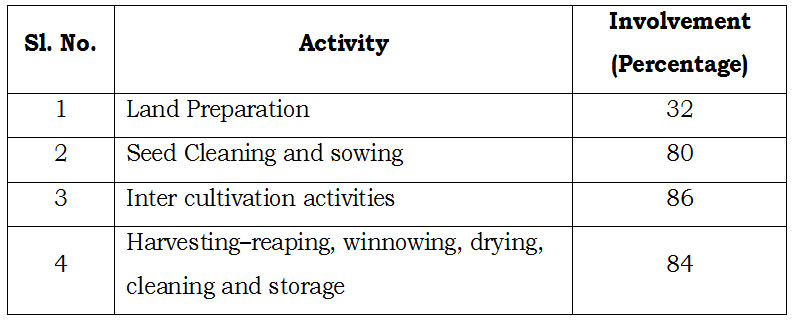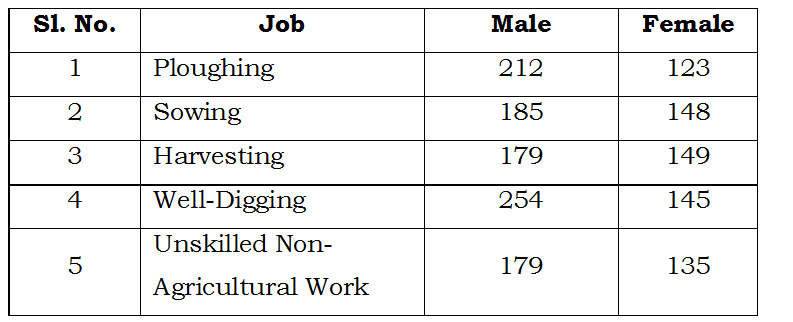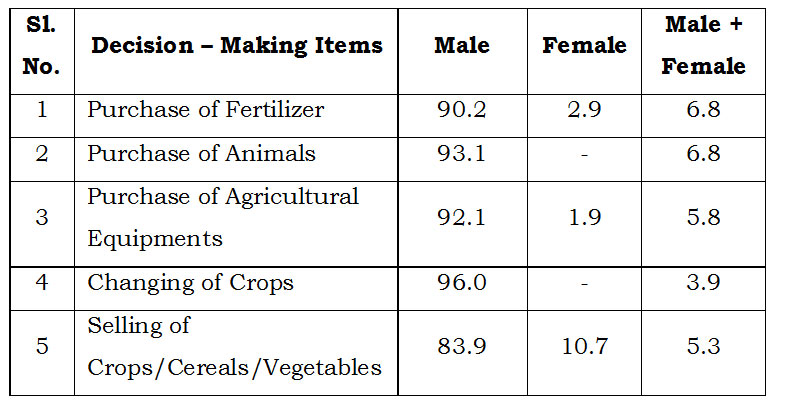Abstract
Women play a significant and crucial role in agricultural development and allied fields including in the main crop production, livestock production, horticulture, post harvest operations, agro-social forestry, fisheries etc, is a fact long taken for granted but also long ignored. The nature and extent of women’s involvement in agriculture, no doubt varies greatly from region to region. Even within a region, their involvement varies widely among different ecological sub-zones, farming systems, castes, classed and stages in the family cycle. But regardless of these variations there is hardly any activity in agricultural production, except ploughing in which women are not actively involved. In some of the farm activities like processing and storage, women predominate so strongly that men workers are numerically insignificant. Studies on women in agriculture conducted in India and other developing and under developed countries all point to the conclusion that women contribute far more to agricultural production that has generally been acknowledged. Recognition of their crucial role in agriculture should not obscure the fact that farm women continue to be concerned with their primary functions as wives, mothers and homemakers.
Keywords: Discrimination, farming and agricultural development
Introduction
In rural India, the prosperity of the household depends on the prosperity of agriculture innumerable activities connected with farming, dairying, sericulture etc. But the women hands are invisible even to this day, so it is not surprising that the agricultural extension activities are mainly a male oriented pursuit. According to Swaminathan, the famous agricultural scientist, “Some historians belive that it was women who first domesticated crop plants and thereby initiated the art and science of farming. While men went out hunting in search of food, women started gathering seeds from the native flora and began cultivating those of interest from the point of view if food, feed, fodder, fibre and fuel”. Women in the agriculture sector continue to suffer lower wage rates relative to their male counterparts. The daily wage disparities have remained fairly constant over the years since 1999, though they did rise somewhat during the early 2000s. As of 2015, disparities in daily compensation between male and female workers have tended to be higher for more physically intensive activities. Wage rates may vary significantly across different agricultural activities, generally depending on the intensity of physical exertion required.
Objectives of the study
The following are the important objectives of the study:
1. To find out the role of women in agriculture and its allied fields,
2. To analyse the gender differences in the activities of agricultural sector, and
3. To find out the various ways and means to reduce gender differences and to improve the role of women in agricultural sector
Multi-Dimensional Role of Women
The role of women in agriculture is sowing, transplanting, weeding, irrigation, fertilizer application, plant protection, harvesting, winnowing, storing etc. In domestic the role of women is cooking, child rearing, water collection, fuel wood gathering, household maintenance etc. In allied activities the role of women is cattle management, fodder collection and milking.
Table: 1
Share of Farm Women in Agriculture

Source: Registrar General of India, New Delhi 2013
The above table shows the share of women involvement in agriculture operations. 32 per cent of women are involved in land preparation agricultural work. 80 per cent of women work in seed cleaning and sowing. 86 per cent of the farms women work in inter cultivation activities in agriculture and 84 per cent of farm women work in harvesting, reaping, winnowing, drying, cleaning and storage related work in agriculture.
Table: 2
Gender Equality Work (Daily wage in Rs.)
Source: Labour Bureau, 2015
Equal pay for equal work is one of the cornerstones of the gender equality movement the world over. But Labour Bureau data show there has been little progress in terms of parity of salaries for man and women for equivalent work in India. Even more alarming is the fact that even though wage disparities have always existed in rural parts of the country, in some spheres of activity, the divide has widened. So, while men were paid 70 per cent higher wages than women for ploughing work at the end of 2009-10, the difference rose to 80.4 per cent in end of March 2014 and stood at 93.6 per cent at the start of 2014-15. As of 2015, the discrimination in wages paid to women tends to be higher in physically intensive activities, but lower in case of work such as sowing and harvesting. Outside the agricultural sphere, it appears that gender stereo types won out once again, if one considers unskilled non-agricultural work.
Women – Decision Making in Agriculture
Women’s role in agricultural operations, animal husbandry and other economically productive activities is very significant. They contribute about 60-70 per cent of the labour required for these activities thus playing a pivotal role in sustaining economy. The decision making process is an important segment of every household because it makes implementation of a plan or programme quite easy. In rural areas both husband and wife are jointly responsible for making decisions on matters like family obligations, specific housing charges and purchase of household articles. However women’s suggestions are not given due consideration in the decisions pertaining to agricultural sector and important family matters. It is because the majorities of women is illiterate, have little time to know about the latest techniques of framing and restricted mobility due to several cultural taboos.
Table: 3
Decision – Making in Agricultural Activities
Source: Labour Bureau, 2015
The poor participation of women in agriculture sector is also confirmed in a study, where women’s opinion is not normally considered and their opinion is also not considered in the matters related to participation in developmental activities. The social role as a decision maker in the production and the distribution of products and their participation and representations in village developmental activities has not changed over the time. In all such social relations men continue to dominate the same and there exists no party of decision making in gender relations.
Moreover women’s exclusion from public life keep them out of the decision making process related to various rural developmental activities such as the utilisation of loans and subsidies under the various Integrated Rural Developmental Programme (IRDP) schemes. Women also fail to get loans sanctioned for agricultural development or various schemes under Rural Employment Programme (REP) women have no representation in the Agricultural Marketing Committees and other similar bodies. The governmental and non-governmental organisations also prefer men for these purposes. Thus, the ideology of segregation and seclusion of women helps in keeping them out of the various decision making process concerning the various facts of rural development. It is for this reason that to find that whereas women’s labour is utilized for both productive as well as non-productive work, the various source of power lies in the hands of men only.
Women’s wage work is considered a threat to the male ego and women’s engagement in multiple home-based economic activities leads to under remuneration for their work. Women spend long hours fetching water, doing laundry, preparing food and carrying out agricultural duties. Not only are these tasks physically hard and demanding they also rob girl’s opportunity to study. The nature and sphere of women’s productivity in the labour market is largely determined by socio-cultural and economic factors. Women do not enter the labour market on equal terms when compared to men. Their occupational choices are also limited due to social and cultural constraints, gender basis in the labour market, and lack of supportive facilities such as child care, transport and accommodation in the formal sector of the labour market.
Conclusion
Rural women are the major contributors in agriculture and its allied fields. Women work ranges from crop production, livestock production to cottage industry. From households and family maintenance activities to transporting water, fuel and fodder. Despite such a huge involvement, her role and dignity has yet not been recognised. Women’s status is low by all social, economic and political indicators. Women’s labour power is considered inferior because of employers predetermined notion of women’s primary role as homemakers. As a result of discrimination against female labour, women are concentrated in the secondary sector of labour market. Their work is low paid, low status, casual and lacks potential upward mobility. The majority of women in the urban sector work in low-paying jobs.
For the recognition of women contribution in agriculture and its allied fields and reducing the gender issues, following are the recommendations:
- Recognition of labour work of working women in the rural economy may be accounted in monetary terms.
- More facilities should be provided to poor rural women for land, agricultural and livestock extension services.
- Priority must be given to women in accessing credit on soft terms from banks and other financial institutions for setting up their business, for buying properties and for house building.
- Measures should be taken to enhance women’s literacy rates. A separate education policy for women may serve the purpose.\
- Women must be involved in decision-making bodies that have the potential to introduce structural changes. This action will bring some changes in the gender relations in the society.
– Dr. G.A. Robert Gixon, M.A., Ph.D*
Associate Professor & Head, Department of Economics, N.M. Christian College, Marthandam.
References:
1. Impact of WTO on women in agriculture by Research foundation Science & Technology, National Commission for Women, New Delhi, 2014.
2. Sethi (2013), “Wage disparities higher in physically demanding work”, The Business Line, July 14, 2013.
3. P.S.J. Sudan (2012), “Wage Discrimination of Women in Agriculture” Paper presentation in State Level Seminar.
4. www.ceicdata.com



